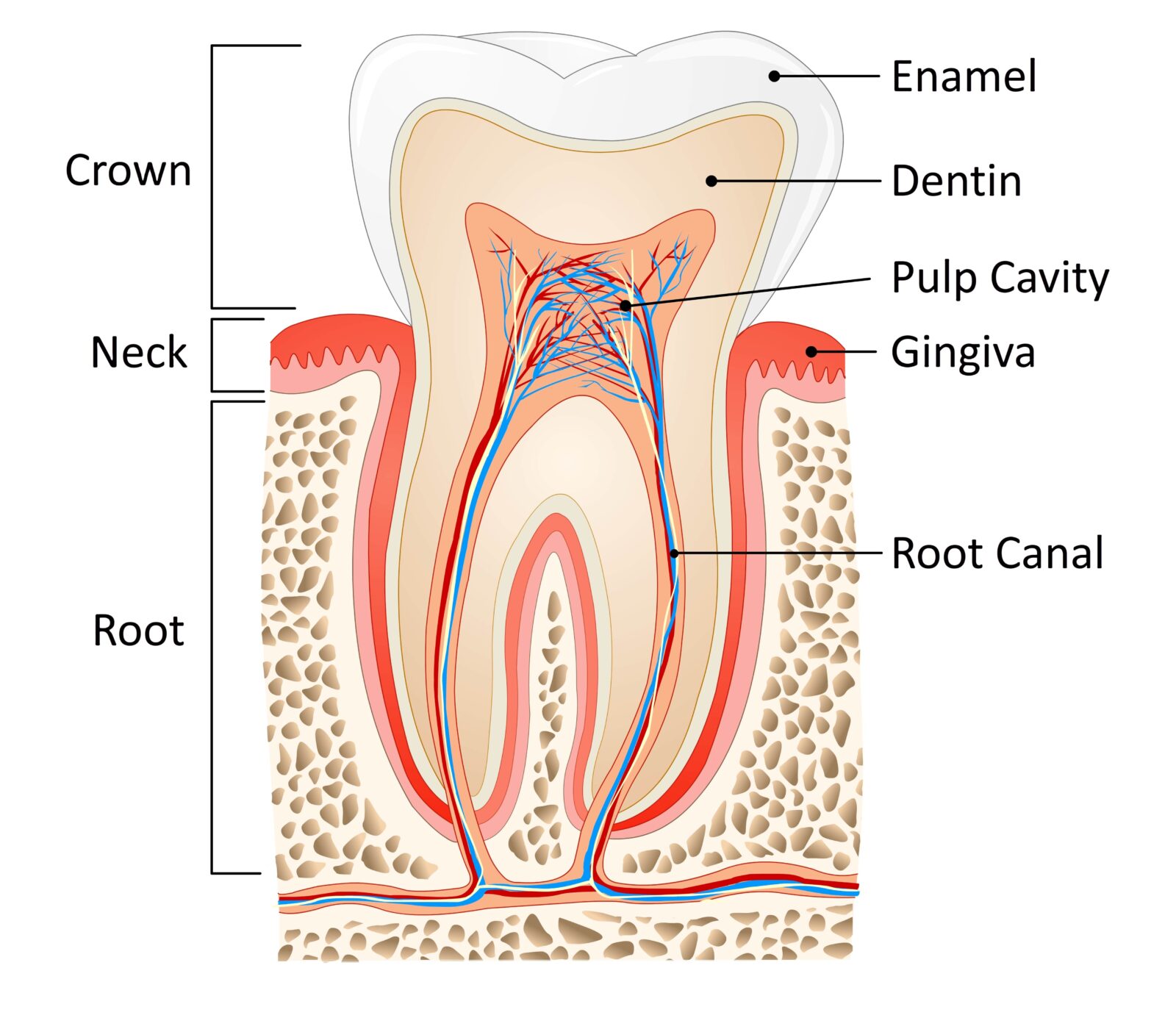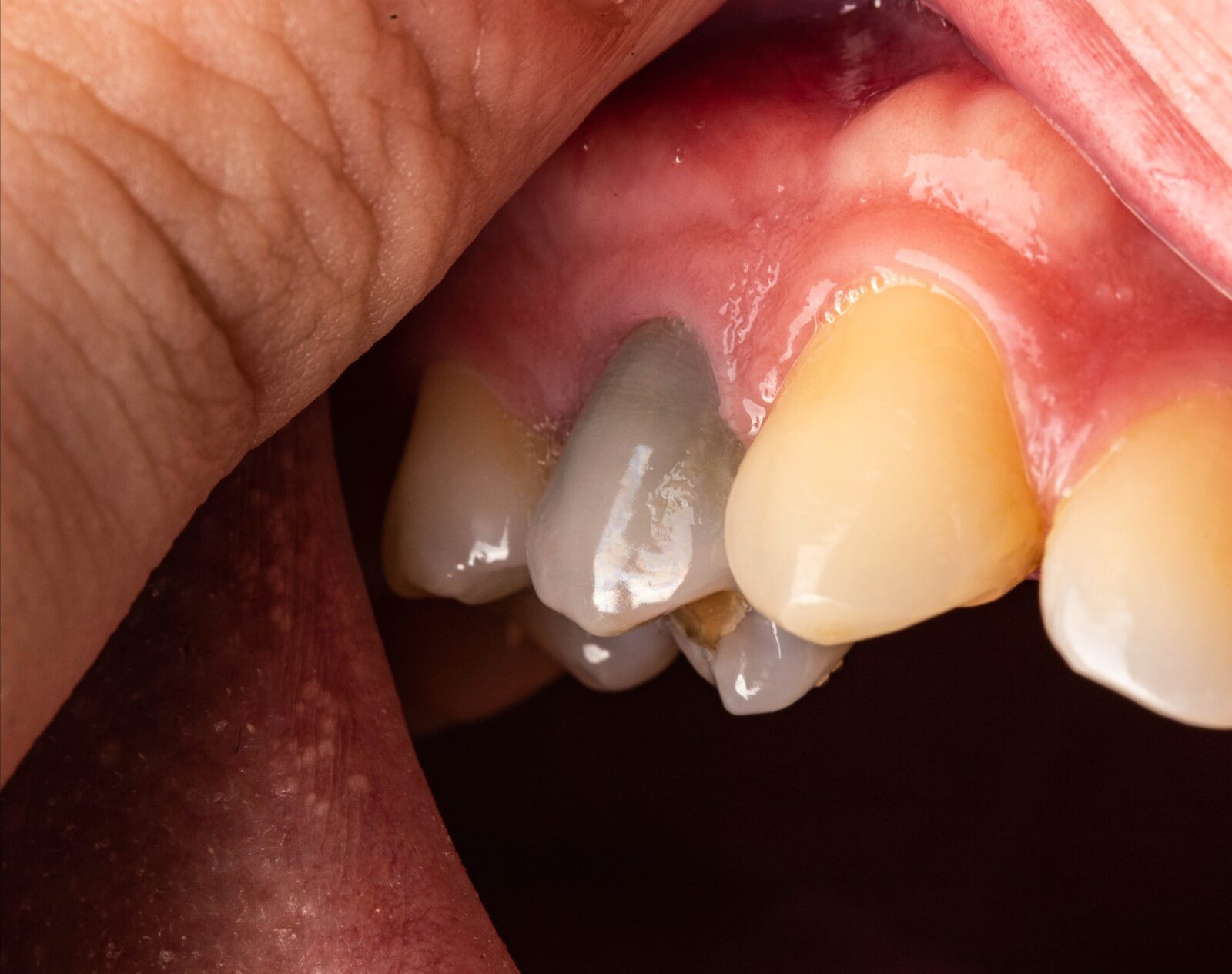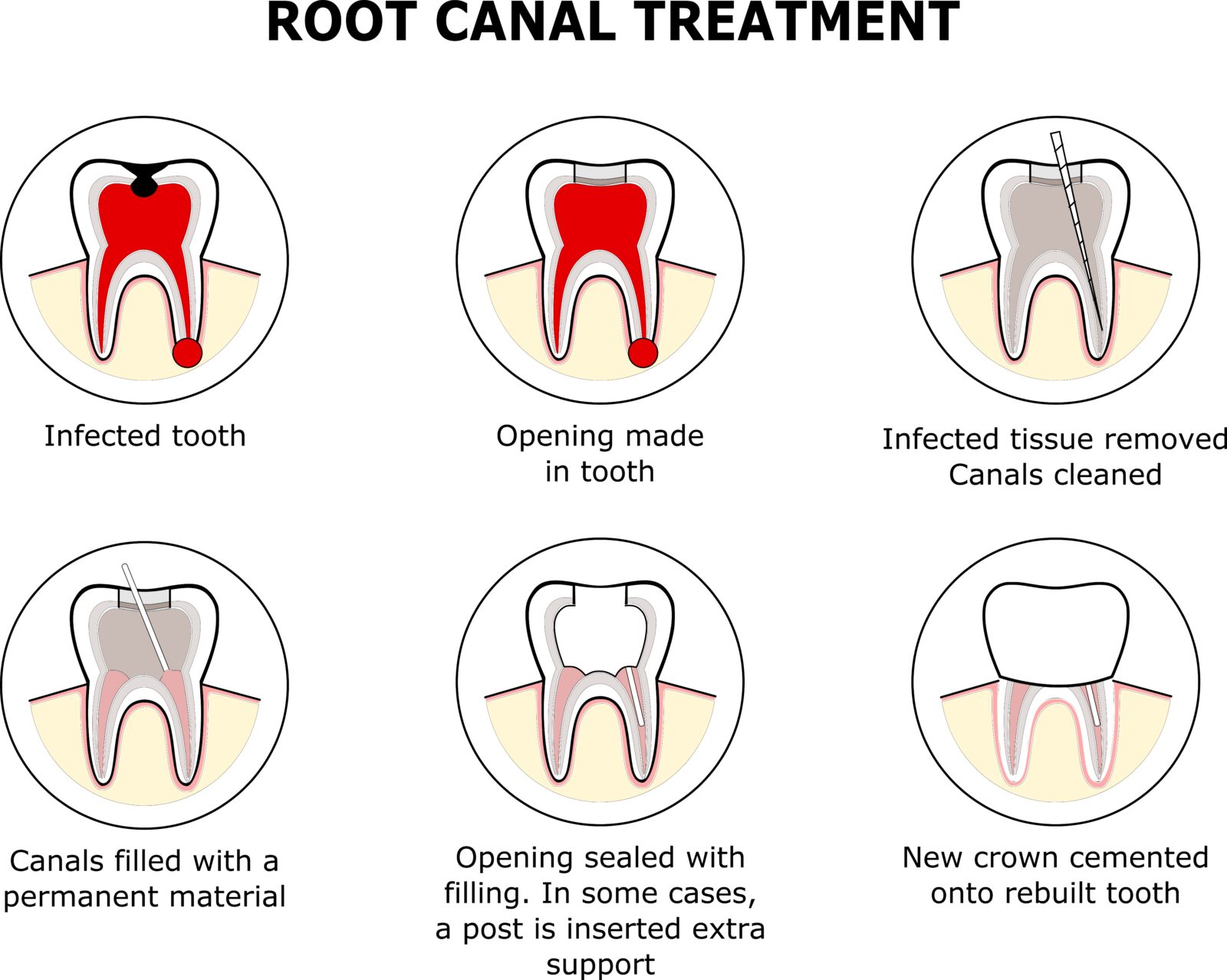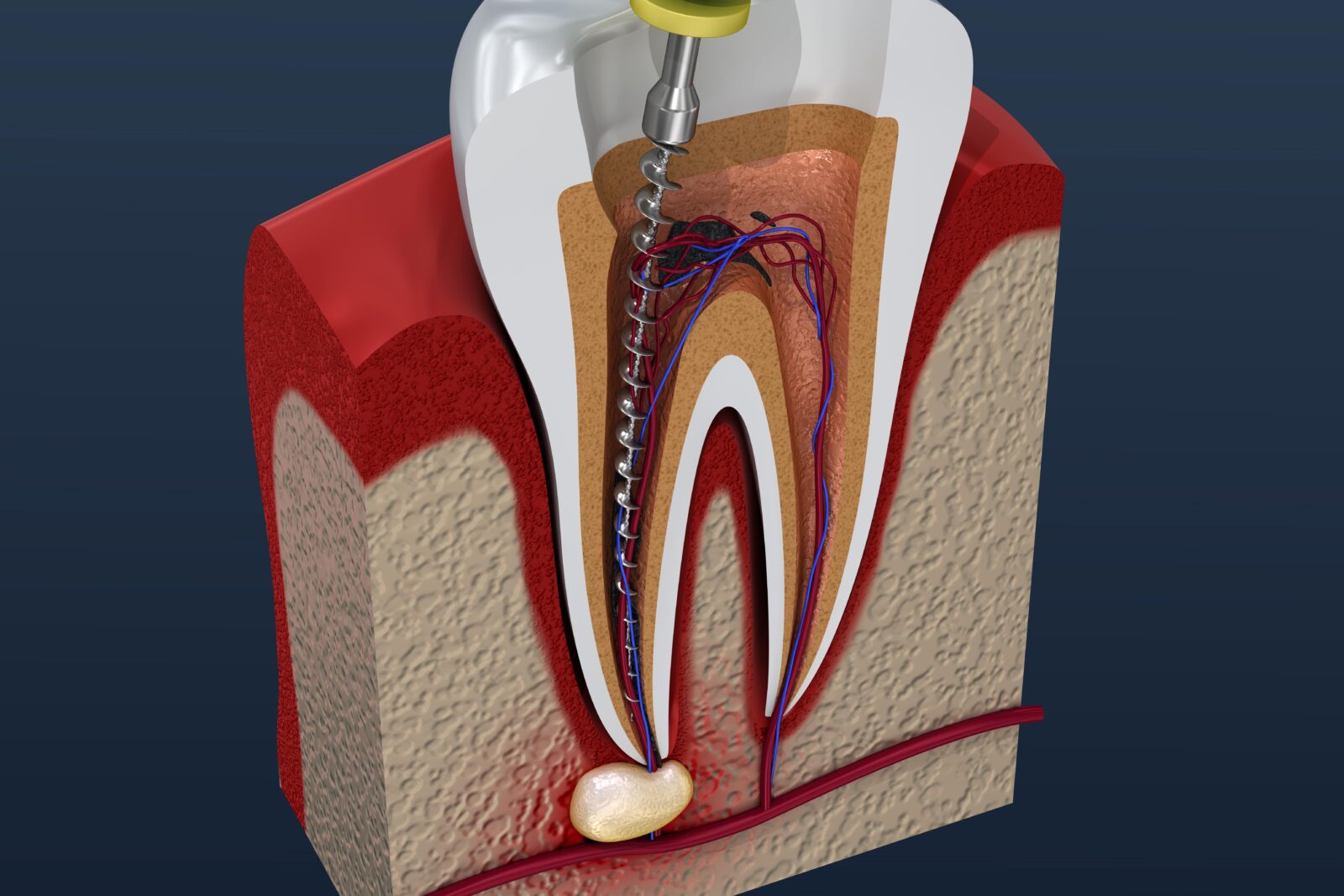Root canal treatment is a dental procedure that many people dread, often due to misconceptions about its pain and complexity. However, understanding what a root canal entails can alleviate much of the fear and anxiety surrounding it. This blog aims to demystify root canal treatment by exploring its purpose, process, and the relief it can bring to those suffering from tooth pain and infection. By dispelling common myths and highlighting the advances in dental technology, we will show how root canal therapy is a safe, effective, and relatively painless way to preserve your natural teeth and maintain oral health. Join us as we delve into the intricacies of root canal treatment, providing you with the knowledge you need to approach your next dental appointment with confidence.
In This Blog:
- Tooth Anatomy and Its Relation to Root Canal Treatment
- Causes of Root Canal Problems
- Symptoms of Root Canal Problems
- The Root Canal Procedure
- After Root Canal Treatment
Tooth Anatomy and Its Relation to Root Canal Treatment
Understanding the anatomy of a tooth is fundamental to comprehending why and how root canal treatment is performed. A tooth is composed of several parts, each with a crucial role in its function and health:

- Enamel: This is the hard, outermost layer that protects the tooth from decay and everyday wear. It’s the hardest substance in the human body and acts as the tooth’s primary defense against physical and chemical damage.
- Dentin: Beneath the enamel is the dentin, a porous layer that provides additional protection and support. It’s softer than enamel and contains microscopic tubules that can transmit sensations to the nerve of the tooth.
- Pulp: The pulp lies at the center of the tooth and contains its blood vessels, nerves, and connective tissues. This part of the tooth is vital during its development and continues to provide nutrients and sensory function once the tooth has matured.
- Root Canals: Within the roots of the tooth are the root canals, which house the pulp down to the tip of the root where it connects to the surrounding tissue. These canals serve as pathways for the nerves and blood vessels to reach the pulp.
- Cementum: Covering the root of the tooth is the cementum, a specialized bony substance that helps anchor the tooth in the jawbone through the periodontal ligament.
When a tooth is healthy, these components work in harmony to allow for biting, chewing, and sensory perception. However, when the pulp becomes infected or inflamed due to decay, cracks, trauma, or repeated dental procedures, it can lead to pain and the potential loss of the tooth. This is where root canal treatment comes into play.
Root canal treatment, also known as endodontic therapy, involves removing the infected or inflamed pulp, cleaning and disinfecting the inner chambers of the tooth (the root canals), and then filling and sealing these spaces. This procedure is essential for preserving the tooth’s structure and preventing the spread of infection to surrounding tissues.
By understanding the anatomy of a tooth, patients can better appreciate the necessity and benefits of root canal treatment. It’s not merely a procedure to relieve dental pain; it’s a sophisticated treatment designed to save a tooth that would otherwise need to be extracted. Keeping the natural tooth in place is often preferable, as it maintains the dental arch integrity, proper chewing function, and natural appearance.
Causes of Root Canal Problems
Root canal problems are typically caused by conditions that affect the pulp of the tooth, the innermost part containing nerves and blood vessels. Here are the primary causes:
Tooth Decay:
The most common cause of root canal problems is deep tooth decay that penetrates the outer layers of the tooth (enamel and dentin) and reaches the pulp chamber, leading to infection and inflammation.
Dental Trauma:
Physical trauma to a tooth, such as a blow or a fall, can damage the pulp directly or cause cracks through which bacteria can enter and infect the pulp.
Repeated Dental Procedures:
Frequent dental treatments on the same tooth can cause stress and inflammation to the pulp, eventually leading to pulp damage or necrosis.
Cracks and Chips:
Tiny cracks or chips in a tooth may not seem significant, but they can provide a pathway for bacteria to enter the pulp chamber and cause infection.
Gum Disease:
Advanced stages of gum disease (periodontitis) can lead to infections that reach down to the root of the tooth and affect the pulp.
These factors can lead to the inflammation or infection of the tooth’s pulp, necessitating root canal treatment to remove the affected tissue, alleviate pain, and prevent the spread of infection.
Symptoms of Root Canal Problems
The symptoms of root canal problems can vary, but commonly include:
Persistent Pain:
A constant or intermittent toothache that can be sharp, throbbing, or dull. The pain might worsen when lying down or during nighttime.
Sensitivity to Hot and Cold:
Teeth that are overly sensitive to hot or cold foods or drinks, where the discomfort lingers for an extended period after the temperature stimulus is removed.
Swelling and Tenderness in the Gums:
Inflammation or swelling in the gum area around the affected tooth, which might be tender or painful to touch.

Discoloration of the Tooth:
A tooth that has become discolored, often turning dark yellow, gray, or black, indicating that the nerve inside the tooth may be dead or dying.
Pain on Chewing or Biting:
Discomfort or increased pain when biting down or chewing can indicate that the infection or inflammation has reached the root tip and is affecting the surrounding bone and tissues.
Prolonged Sensitivity to Sweet or Acidic Foods:
Similar to thermal sensitivity, a lasting pain after consuming sweet or acidic foods or drinks can signal pulp damage.
A Persistent or Recurring Pimple on the Gums:
Often referred to as a sinus tract, this pimple may ooze pus and is a sign of an underlying abscess resulting from the infection in the pulp.
Looseness of the Tooth:
In some cases, the affected tooth may feel looser, which can be a sign of infection spreading and affecting the supporting bone structures.
Experiencing one or more of these symptoms can indicate a root canal problem and should prompt a visit to a dentist or endodontist for evaluation and treatment to prevent further damage and potential tooth loss.
The importance of timely root canal treatment cannot be overstated, as it is crucial in preventing the spread of infection and preserving the natural tooth. Delaying treatment can lead to severe pain, increased infection, and the potential development of an abscess, which can be a serious health risk if the infection spreads to other areas of the body.
Early intervention stops the infection at its source, alleviating pain and restoring the tooth’s functionality. Moreover, treating the tooth promptly can prevent more complex and costly dental procedures in the future, such as tooth extraction and replacement with dental implants or bridges. Timely root canal treatment not only saves the tooth but also maintains the overall health and balance of the mouth, ensuring that one’s oral health is preserved and contributing to general well-being.
The Root Canal Procedure
Root canal procedures are performed to remove infected or inflamed pulp tissue from within the tooth, thereby alleviating pain and preventing further infection. Here’s a step-by-step overview of how root canals are typically performed:
Diagnosis and X-ray:
The dentist will start with a thorough examination of the affected tooth and surrounding gums. X-rays are taken to assess the extent of the damage and to visualize the shape and number of root canals.
Local Anesthesia:
To ensure the procedure is pain-free, local anesthesia is administered to numb the tooth and surrounding area.
Creating an Access Opening:
A small opening is made in the crown of the tooth to gain access to the pulp chamber and root canals.
Removing the Pulp:
Specialized dental instruments, like files, are used to remove the infected or inflamed pulp tissue from inside the tooth and root canals.

Cleaning and Shaping:
The empty canals are then cleaned and shaped to prepare them for filling. This process removes any remaining bacteria and debris and shapes the canals to receive the filling material.
Disinfecting:
The canals are flushed with disinfectant solutions to kill any remaining bacteria and reduce the risk of further infection.
Filling the Canals:
Once the canals are clean and dry, they are filled with a biocompatible material, usually a rubber-like substance called gutta-percha. This material is placed along with an adhesive cement to ensure the canals are completely sealed.
Restoring the Tooth:
After the root canal treatment, the access hole in the crown of the tooth is sealed with a temporary filling. Eventually, a permanent restoration, like a crown or a filling, will be placed to restore the tooth to its full function and appearance.
Follow-Up:
After the procedure, a follow-up appointment may be necessary to ensure the tooth is healing properly and to place the final restoration.
Modern root canal treatments are highly successful and can often be completed in one or two visits, depending on the complexity of the case. With proper care and maintenance, a tooth that has received a root canal can last a lifetime.
After Root Canal Treatment
After root canal treatment, patients typically go through a recovery period, during which they may experience some sensitivity or discomfort in the treated area. Here’s what typically happens post-treatment:
Temporary Sensitivity:
After the anesthesia wears off, the tooth and surrounding area may feel tender or sensitive for a few days. This is normal and can usually be managed with over-the-counter pain medications.
Chewing and Eating:
Patients are often advised to avoid chewing on the side of the treated tooth until it has been fully restored with a permanent filling or crown to prevent any damage.
Oral Hygiene:
Maintaining good oral hygiene is crucial after root canal therapy. Patients should continue to brush and floss regularly, taking care to be gentle around the treated area to avoid irritation.
Follow-Up Visits:
A follow-up appointment with the dentist is necessary to monitor the healing process and to place the permanent restoration on the treated tooth. This could be a crown or a filling, which helps protect the tooth from future damage and restores its full function.
Observation of Symptoms:
Any ongoing symptoms or new issues, such as severe pain, visible swelling, or an allergic reaction to the materials used, should be reported to the dentist immediately. While rare, these could indicate the need for further treatment or adjustment.
Restoration of the Tooth:
The final step in the root canal process is often the placement of a crown or other restoration to fully restore the tooth’s shape, appearance, and function. This step is vital to protect the tooth from fracture and to ensure its durability over time.
Recovery from root canal treatment is usually quick, with most patients resuming their normal activities within a day. With proper care and attention, a tooth that has undergone root canal therapy can function well and last as long as the rest of the teeth.
Conclusion
In conclusion, root canal treatment is a vital dental procedure that effectively addresses problems within the tooth’s pulp, alleviating pain and preventing the spread of infection. While the prospect of undergoing a root canal may seem daunting, understanding the process and its benefits can alleviate fears and misconceptions. Timely treatment is crucial to preserving natural teeth and maintaining overall oral health, preventing more severe complications down the line. With advancements in dental technology and techniques, root canal therapy has become more comfortable and successful, ensuring that patients can retain their natural teeth and enjoy a healthy, functional smile for years to come.







